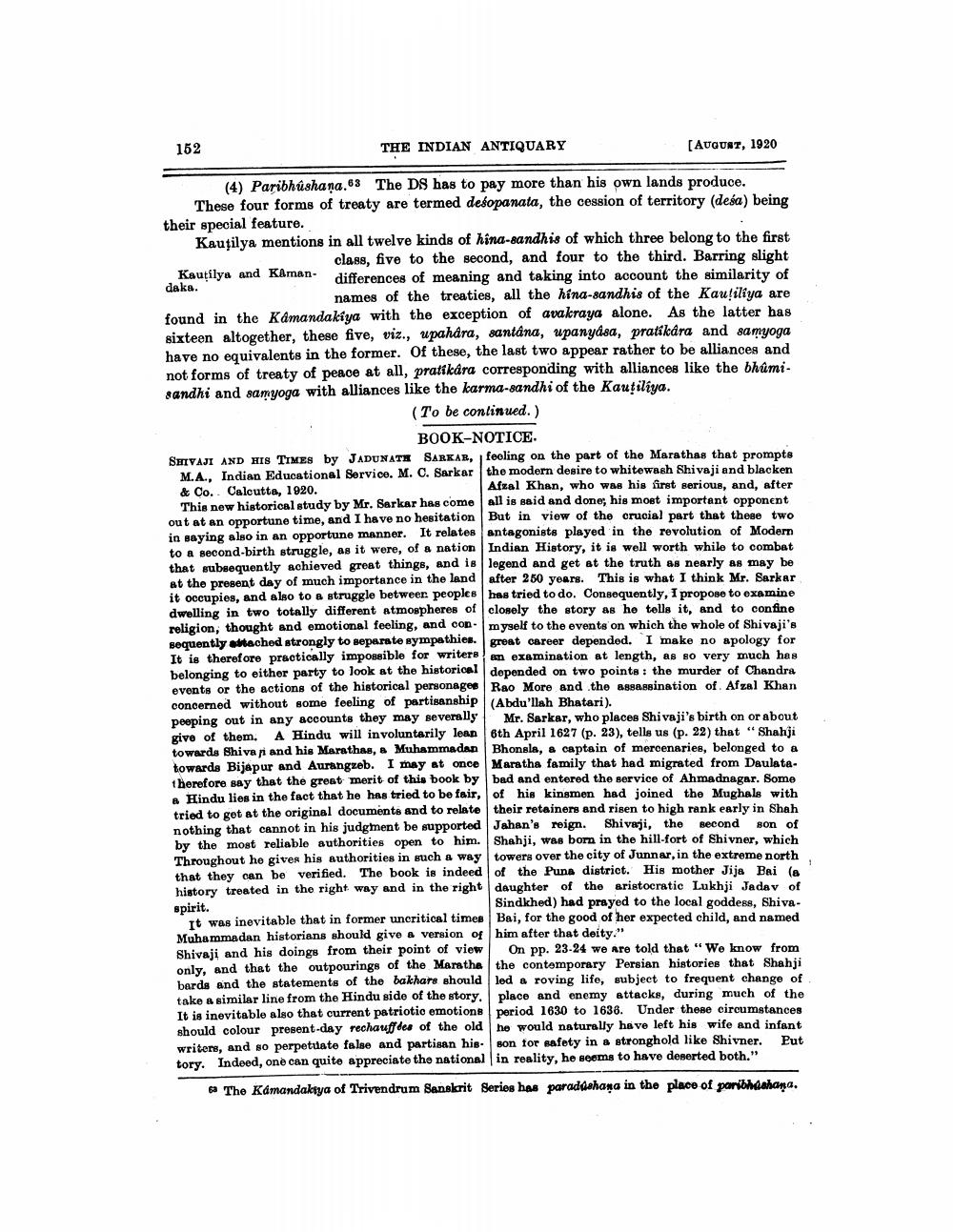________________
152
THE INDIAN ANTIQUARY
[AUGUST, 1920
(4) Paribhushana.63 The DS has to pay more than his own lands produce. These four forms of treaty are termed desopanata, the cession of territory (desa) being their special feature.
Kautilya mentions in all twelve kinds of hina-sandhis of which three belong to the first class, five to the second, and four to the third. Barring slight differences of meaning and taking into account the similarity of names of the treaties, all the hina-sandhis of the Kauțiliya are found in the Kamandakiya with the exception of avakraya alone. As the latter has sixteen altogether, these five, viz., upahára, santâna, upanyasa, pratikára and samyoga have no equivalents in the former. Of these, the last two appear rather to be alliances and not forms of treaty of peace at all, pratikára corresponding with alliances like the bhûmisandhi and samyoga with alliances like the karma-sandhi of the Kauțiliya.
(To be continued.) BOOK-NOTICE.
Kautilya and Kamandaka.
This new historical study by Mr. Sarkar has come out at an opportune time, and I have no hesitation in saying also in an opportune manner. It relates to a second-birth struggle, as it were, of a nation that subsequently achieved great things, and is at the present day of much importance in the land it occupies, and also to a struggle between peoples dwelling in two totally different atmospheres of religion, thought and emotional feeling, and consequently attached strongly to separate sympathies. It is therefore practically impossible for writers belonging to either party to look at the historical events or the actions of the historical personages concerned without some feeling of partisanship peeping out in any accounts they may severally give of them. A Hindu will involuntarily lean towards Shivaji and his Marathas, a Muhammadan towards Bijapur and Aurangzeb. I may at once therefore say that the great merit of this book by a Hindu lies in the fact that he has tried to be fair, tried to get at the original documents and to relate nothing that cannot in his judgment be supported by the most reliable authorities open to him. Throughout he gives his authorities in such a way that they can be verified. The book is indeed history treated in the right way and in the right spirit.
feeling on the part of the Marathas that prompts the modern desire to whitewash Shivaji and blacken Afzal Khan, who was his first serious, and, after all is said and done; his most important opponent But in view of the crucial part that these two antagonists played in the revolution of Modern Indian History, it is well worth while to combat legend and get at the truth as nearly as may be after 250 years. This is what I think Mr. Sarkar has tried to do. Consequently, I propose to examine closely the story as he tells it, and to confine myself to the events on which the whole of Shivaji's great career depended. I make no apology for an examination at length, as so very much has depended on two points: the murder of Chandra Rao More and the assassination of Afzal Khan (Abdu'llah Bhatari).
Mr. Sarkar, who places Shivaji's birth on or about 6th April 1627 (p. 23), tells us (p. 22) that "Shahji Bhonsla, a captain of mercenaries, belonged to a Maratha family that had migrated from Daulatabad and entered the service of Ahmadnagar. Some of his kinsmen had joined the Mughals with their retainers and risen to high rank early in Shah second son of Jahan's reign. Shivaji, the Shahji, was born in the hill-fort of Shivner, which towers over the city of Junnar, in the extreme north of the Puna district. His mother Jija Bai (a daughter of the aristocratic Lukhji Jadav of Sindkhed) had prayed to the local goddess, ShivaBai, for the good of her expected child, and named him after that deity."
1
It was inevitable that in former uncritical times Muhammadan historians should give a version of Shivaji and his doings from their point of view only, and that the outpourings of the Maratha bards and the statements of the bakhars should take a similar line from the Hindu side of the story. It is inevitable also that current patriotic emotions should colour present-day rechauffées of the old writers, and so perpetuate false and partisan his tory. Indeed, one can quite appreciate the national | in reality, he seems to have deserted both."
On pp. 23-24 we are told that "We know from the contemporary Persian histories that Shahji led a roving life, subject to frequent change of place and enemy attacks, during much of the period 1630 to 1638. Under these circumstances he would naturally have left his wife and infant son for safety in a stronghold like Shivner.
Put
63 The Kamandakaya of Trivendrum Sanskrit Series has paradushana in the place of paribhashana.
SHIVAJI AND HIS TIMES by JADUNATH SARKAR, M.A., Indian Educational Service. M. C. Sarkar & Co. Calcutta, 1920.




